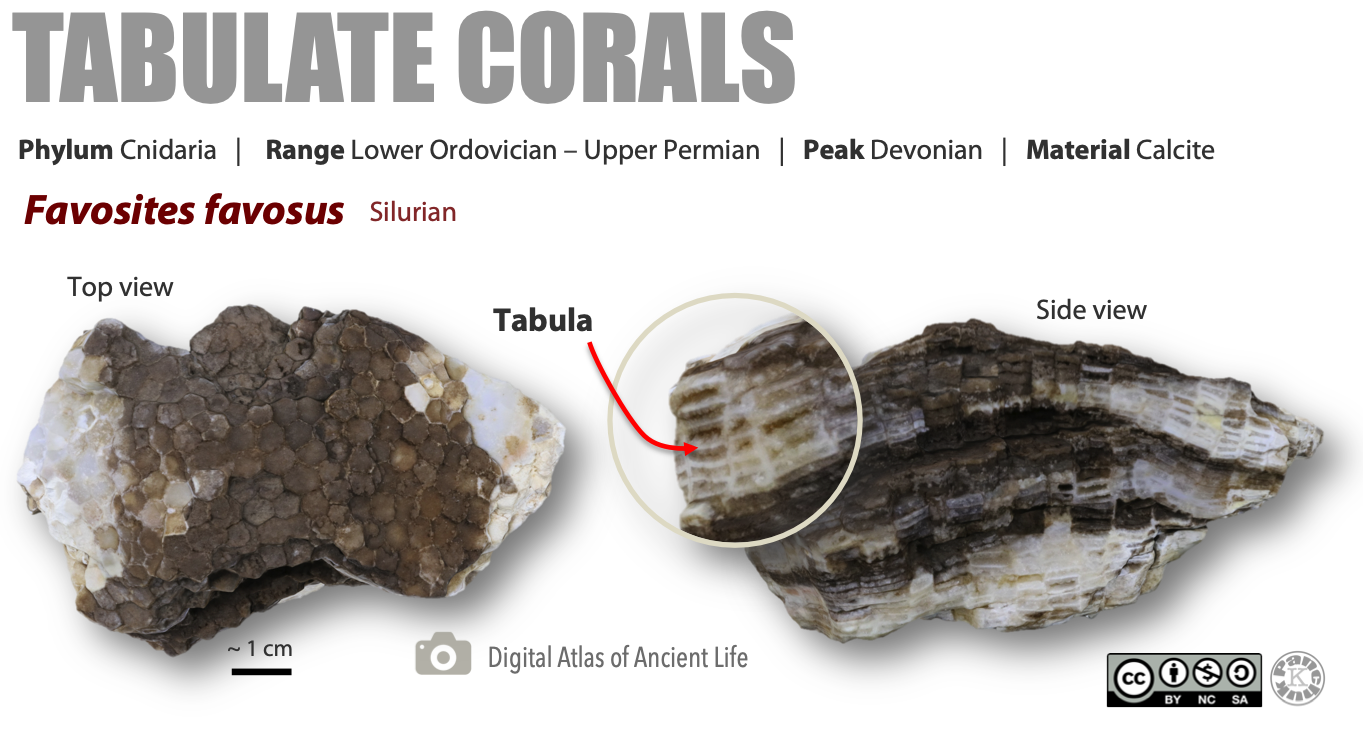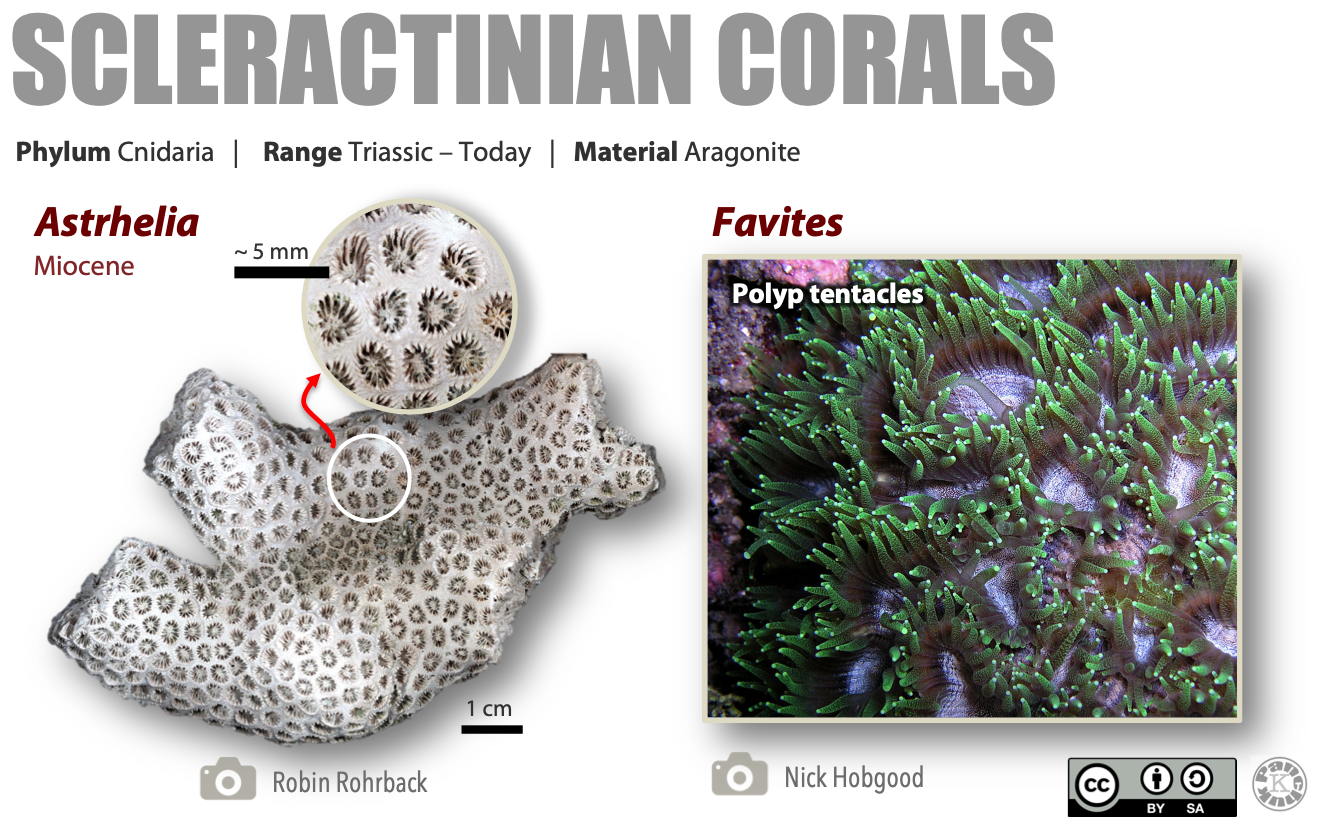Fossils of the Paleozoic: Phylum Cnidaria (The Corals)
In Lab 6 we introduced Phylum Cnidaria with the jellies and sea anemones. The most important group within Phylum Cnidaria are the corals.
Corals are multicellular animals that have a similar life habit to sea anemones. They are anchored to the ocean floor and precipitate a mineral framework around themselves which raises them up off the sea floor to more efficiently collect food.
Each coral animal is known as a polyp. Polyps are suspension feeders, meaning that they use tentacles to collect food floating past in the water. Each polyp possesses muscular tissues that allow it to move parts of its body. It is shaped like a pouch with an opening on the top. Food is digested in the pouch and the waste is then ejected back out the same opening. They possess stinging cells on their tentacles that can paralyze small prey. Corals may live either as a colony of many genetically identical animals or non-colonial as a solitary polyp.
Want to Know More About Corals?
Corals are not actually a simple organic eating animal. The coral animal gains some of its nutrients from unicellular algae that they hold inside their tissue in a symbiotic (mutually beneficial) relationship. They provide nutrients to the algae and in return gain organics (food) directly from the algae waste products. The colours that you see in photographs of corals are actually due to these algae, not the coral animal itself which is mostly translucent.
Corals generally grow in warm shallow water. However, if water temperatures become too warm the captive algae become too active, producing too much waste for the coral to deal with. The coral animals may then eject the algae. This process is known as “coral bleaching” because the colourful algae are no longer present. The coral polyps lose some of their food source and can be very vulnerable in this state.
Corals are geologically the most important group within this phylum because their calcium carbonate frameworks are easily preserved. Over the Paleozoic and Mesozoic different corals have been important reef builders. There have been three major types of corals: rugose, tabulate, and scleractinian. Rugose and tabulate corals were important in the Paleozoic, but did not make it past the Permian extinction. Scleractinian corals were important after the Permian and into the present.
Rugose corals (Figure 7.5) have calcite structures. They can be solitary or colonial, but are best known for the solitary horn shape, giving it the common name of “horn coral.”

Tabulate corals (Figure 7.6) also have calcite structures. They can be solitary or colonial, but are best known for colonial forms that grow in a tight structure resembling a honeycomb. A key distinguishing feature is horizontal partitions called tabulae (singular tabula). As the polyp grows it continues to build tabulae and to live in the top “chamber”.

Scleractinian corals (Figure 7.7) make their structures out of the calcium carbonate mineral aragonite. They can be solitary or colonial, and if you find a living coral in nature with a hard skeleton, it will be a scleractinian coral. They have well developed six-sided “cups” with many small radial dividers. The inside of the cup in scleractinian corals resembles that of the rugose corals, and in fact there are small differences in the arrangement of these dividers that distinguish the rugose and scleractinian corals. Scleractinian corals are also more regularly colonial compared to the more commonly solitary rugose corals. In this course we will see only colonial scleractinian forms.

Questions a & b
a. From your general knowledge, what zone do modern corals live in—photic, bathyal, or abyssal?
b. Describe their habit using the terms from Figure 7.2. (Click here to open Figure 7.2 in a new window).
Rugose Corals
A. Sample 3: Solitary Rugose Coral
These samples can be picked up but please treat them with care.
Each sample is the fossilized calcite support framework for a single animal. Corals are suspension feeders and these frameworks gradually raise the animal up off the ocean floor, making it easier to capture food moving past in the water. Notice how the radius of the coral framework got larger as the coral animal grew.
Question c
B. Sample D11: Colonial Rugose Coral
This sample can be picked up but please treat it with care.
Questions d & e
d. What mineral is the skeleton of this coral constructed with?
e. Sample D11 is from Phylum Cnidaria, Class Anthozoa, and Order Scleractinia. It has been tentatively identified as Acrocyathus floriformis. What is the species-level name of Sample D11?
Tabulate Corals
C. Sample D12: Favosites Coral
This sample can be picked up but please treat it with care.
Examine this specimen and find where each individual coral animal lived. Each animal would likely have been genetically identical, reproducing by budding off a little polyp or by dividing itself. Corals also reproduce sexually by releasing both sperm and eggs into the ocean.
D. Samples D15 & D16: Halysites Corals
These samples can be picked up but please treat them with care.
Questions f & g
Samples D15 and D16 have been preserved differently.
f. Which sample has been preserved by permineralization? (For the permineralized sample, the original fossil material is present and infilled by new material.)
g. Which sample has been preserved by recrystallization? (Note that the sample has not been fully recrystallized.)
Scleractinian Corals
E. Sample FL1: Modern Corals
These samples can be picked up but please treat them with care.
These modern corals have well-formed dividers in each “cup.” Rugose and scleractinian “cups” look similar, but there are small differences that allow paleontologists to tell them apart. As an amateur paleontologist, you are not expected to be able to identify these differences.
Questions h & i
h. What type of symmetry does this sample have? (Focus on the cups.)
i. What type of preservation is displayed in this sample?
